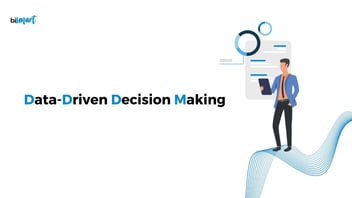Making decisions based on data is key to ensure the progress of our business. Here you will find 8 simple steps to make data-driven decisions.
Long gone are the days when businesses made decisions based on instincts or uninformed beliefs. Advanced data analytics has become a key aspect of any company's activity . We talk about the power of data-driven decisions and why they are the key to ensure the good performance of a company.

Data strategies based on data intelligence are trending, it's a fact. However, unlike other trends, this one is here to stay as its value in the business world continues to grow.
New technologies and their ability to obtain information have revolutionized the business world, making business intelligence one of the decisive elements for the progress and growth of an organization. With the arrival of digitalization and Big Data, companies now have all the necessary information at their fingertips. Thanks to this, today it is possible to make informed decisions - based on data - that, in practice, will give better results and lead to the growth and evolution of the business.
Obviously, having a large amount of data does not always result in making better decisions. In order to achieve them, it is necessary that the data is processed and analyzed and treated correctly, by specialists in the field, so that they become insights. As we have already explained in this blog, information and insights are not the same. Insights are data that has been treated to provide value, knowledge and allow us to better understand a specific aspect of our business activity, based on specific contexts and goals.
What Are Data-Driven Decisions?
As the name implies, data-driven decisions are decisions based on data (DDD). In this case, business decisions are made from a process that involves collecting data based on measurable goals or KPIs, analyzing and processing the data so that it turns into insights and transforming it into visual and understandable information. In other words, data-based decision making involves working to achieve business objectives, through data that is verified and analyzed.
When we collect data with the intention of supporting business decision making, it is essential that the data is related to those goals and business strategies that we want to develop, based on a specific business area and context. Without conscious data analysis that allows us to extract insights and knowledge that have real value to the company, decision making will not be effective.
In this sense, other processes related to data such as data management, data governance and data visualization are particularly relevant; procedures that greatly facilitate the process of making data-driven decisions and support their operation.
What is Data-Driven Decision Making?
Data-driven decision making is the process of using concrete data and insights that have been previously been analyzed and curated to make informed business decisions. By collecting and analyzing data that is related to specific goals and strategies, companies can gain valuable knowledge and understanding of their business activities. This allows them to identify opportunities, optimize resources, predict future trends, and ultimately generate more revenue.
In fact, research has shown that companies that base their decisions on data achieve higher productivity and profitability compared to those that do not. To effectively implement data-driven decision making, it is important for organizations to foster a data-driven culture throughout the entire company and prioritize data collection, analysis, and visualization. By following these tips and ensuring that decisions are guided by data rather than personal beliefs, companies can make more informed and successful decisions that lead to long-term success in today's ever-changing digital landscape.
The Importance Of Data-Driven Decisions for Companies
Data-driven decisions are the basis for informed decision making. Making decisions based on instincts or beliefs that are not supported by proven, verified, and worked-up information can translate into poor outcomes. On the other hand, making decisions based on quality data and insights that allow us to reach conclusions and, consequently, make better decisions, is much more effective.
Making decisions based on data allows companies to generate knowledge, discover business opportunities, identify pain points, predict future trends, optimize resources and team efforts, create new business strategies and generate more revenue. In fact, a study by two Sloan School of Management professors, Andrew McAfee and Erik Brynjolfsson, found that companies that based their decisions on data achieved 4% higher productivity and 6% more profit than those that did not.
Furthermore, data-driven decisions help businesses to ensure their continuity over time. Today, the market is more unpredictable than ever and the digital world is in a state of constant change. The only way for a company to adapt to this volatile environment is to make informed business decisions driven by data.
Data must be, nowadays, a business asset present in all departments of a company. To optimize business activity, it is optimal that data-driven culture is part of the whole company.
Download tips
8 Tips For Making Data-Driven Decisions
1. Don't listen to your beliefs (too much)
Obviously, when we make decisions, much of our mental process is guided by the unconscious. In life, most decisions we make are not based on totally logical reasoning and instinct and prejudice —understood as beliefs that condition our vision of reality— can lead us to conclusions that have no real solid basis. This reasoning procedure is intrinsic to any human being and can also condition us when interpreting business data. For this reason, it is advisable that decision making is carried out in teams, so that the interpretation of reality is not clouded by prejudice or individual instincts.
In this sense, data visualization gains relevance, since it is the best way to democratize data and, therefore, make it possible for any person —whether they are an expert in data analysis or not— to interpret the information and understand it. Thus, the more team members can interpret the data and reach conclusions, the more informed decisions will be made in all departments of the company, being the data and not the personal beliefs that guide the decision making.
2. Define clear goals
As already mentioned, data-driven decisions are based on data that has been collected, processed and analyzed based on business goals. It is therefore essential that the definition of concrete and precise goals be carried out before moving on to data analysis.
When working with data it is essential to be clear about what goals we want to achieve, what business strategies support the data we are dealing with and what the most important needs of the company are. In short, it is essential to define clear and precise KPIs (Key Performance Indicators) before working with the data.
In the business world, there are a lot of KPIs that we can rely on. It is advisable not to base ourselves on all existing KPIs and to rely only on those that are most relevant to our organization.
3. Proper data collection
Making the right decisions starts with collecting the right data. In fact, having the right data is as important as asking the right questions. That's why it's important to be aware of all the data we have, what we need for each business goals, which are priorities, etc. In this sense, asserting the security of our data and making sure of the quality of our data is also essential.
To optimize data collection, data integration using appropriate tools such as ETLs is also essential. In addition, when analyzing the data it is essential to have organized and updated dashboards to easily manage the large amount of data we will be storing.
4. Find unresolved questions
Once business strategies and goals have been defined, it is time to reflect on the questions we must ask ourselves in order to achieve the defined goals. Asking the right questions makes it easier to focus on the right data and speeds up the data analysis and decision making process, while saving time and money.
Thus, if we base data analysis on the questions we need to solve, it will be much easier for us to draw conclusions and analyze the data with a specific purpose in mind. In addition, it is convenient to build on those questions we have not yet answered and work to resolve those points we are not certain about.
5. Prioritize data
Most companies have a large amount of data stored in their databases and software. Data overload can cause confusion and make it difficult to reach conclusions. Because of this, it is appropriate to prioritize data and focus only on those that have value and will help us answer the questions and achieve the goals we have set.
6. Data Analytics
Once we have the right data, collected based on our business goals and the questions we need to answer, we must proceed to analyze the data. As already mentioned, it is pertinent to have dashboards and data analysis programs such as Power BI to make the process easier and help us transform data into insights.
When carrying out the analysis, it is essential not to forget the importance of the context and to carry out the analysis based on a concrete situational framework.
7. Carry Out Revisions
It is crucial to re-evaluate our analysis, our reports and our conclusions more than once to ensure that they are truly accurate. It is advisable to make periodic revisions, allowing a short interval of time between each revision, since the first time we do something is usually not the most accurate. Revisions allow us to find mistakes and inaccuracies. Identifying mistakes is much more difficult the first time we do something and, as we review our work, we will find more points to improve.
That's why checking the data and making sure we're basing ourselves on the right metrics can be the key to making the right decisions. In this regard, we again recommend that the conclusions do not fall to one person and that they are discussed among different team members to obtain more points of view and enrich the process and the results.
8. Present The Data Visually
Presenting data and information visually so that they are understandable is another crucial step in making data-driven decisions. Creating visualizations from the data is the best way to make sure that the data can be interpreted and that our analysis efforts are not left to nothing because no one else can understand them. In addition, having clear and up-to-date reports is a way to obtain a much more complete and clearer picture of our overall business activity.
Developing the right data visualizations will make it much easier for us to identify KPIs, and it will speed up the whole procedure of reaching conclusions and making decisions.
Nowadays, there are numerous softwares and applications to create visuals. In Bismart, a Microsoft Power BI partner company, we create data visualizations with Power BI, one of the tools on the market that best achieves attractive, interactive and understandable visualizations. Also, in a previous post, we reviewed the best Power BI visuals.
Data-driven decisions and data quality
When it comes to data-driven decisions, the quality of the data being used is of utmost importance. In Bismart we often say that the quality of your decisions depends on the quality of your data.
In order to make informed and successful decisions, organizations must prioritize data collection, analysis, and visualization. Without accurate and reliable data, the decisions made may be based on flawed information, leading to poor outcomes. Data quality is crucial in ensuring that the insights and conclusions drawn from the data are trustworthy and can be used to guide decision making. By following the tips mentioned earlier, such as proper data collection and prioritizing data, organizations can ensure that the data being used for decision making is of high quality. A data-driven culture that values and prioritizes data integrity is essential for making effective decisions that lead to long-term success in today's digital landscape.
Conclusion
In short, making informed decisions is much more profitable and will mean better results for any company. At Bismart, we believe that data is the key for making better decisions. Data-driven decisions ensure that we are making the right decisions to meet specific objectives and promote strategies that make our business grow.
If you want to have this content in your computer, you can access the content here:



